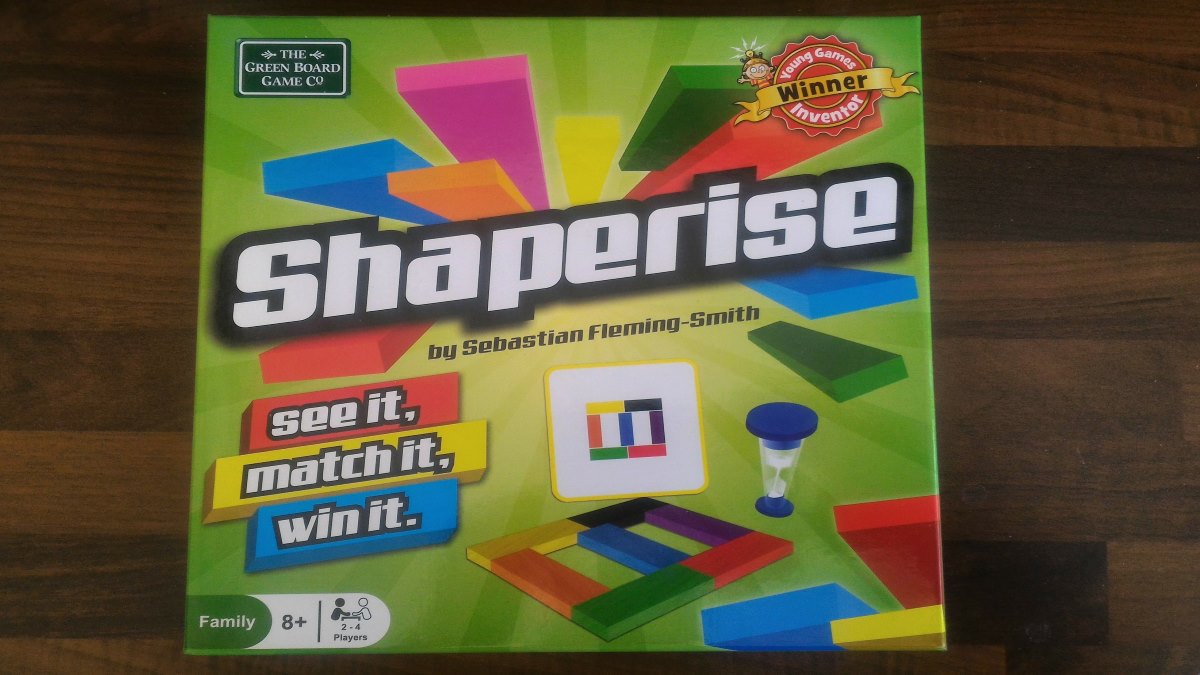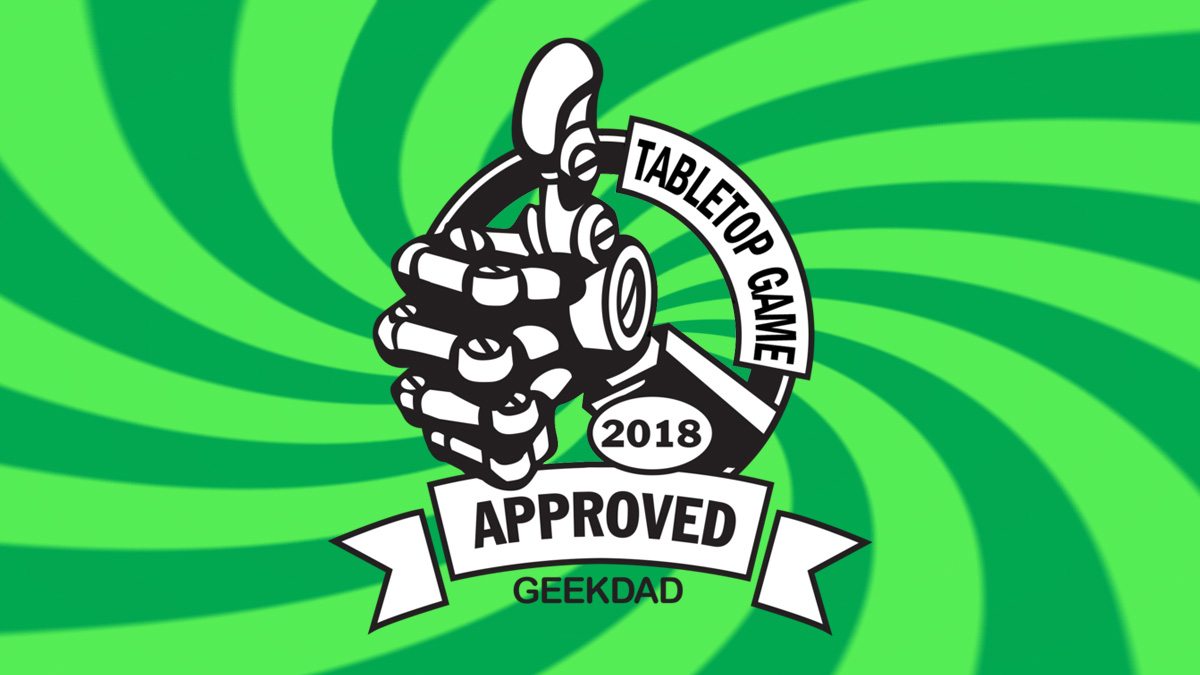 Shaperise is a colorful, fun memory game for the whole family. Quick to learn, hard to master, it is perhaps most remarkable for the fact it was designed by an eleven-year-old boy.
Shaperise is a colorful, fun memory game for the whole family. Quick to learn, hard to master, it is perhaps most remarkable for the fact it was designed by an eleven-year-old boy.
British games company The Green Board Game Company runs an annual “Young Board Games Inventor” competition. Shaperise was their 2016 winner. The prize is to win your own height in Green Board Company Games (they’re the company behind the very successful Brainbox range) AND to have a full version of your game made up. Sebastian Fleming Smith, the young inventor of Shaperise, saw his invention taken one step further. The Green Board Game Company liked it so much they have taken it to full production and it’s now available to buy.
Considering its admirable genesis, the age of its inventor, and its sheer playability, Shaperise can be considered GeekDad Approved. Read on to find out why.

Shaperise is GeekDad Approved!
What is Shaperise?
It’s a memory game for 1-4 players, aged anywhere from 6 upwards, depending on levels of concentration. Using colored rectangles, players must recreate patterns given on the game’s cards. There are three levels of challenge, Easy, Medium, or Hard. The game can be played seriously or just for fun. Individually or in teams. For points or just for the challenge. The game retails at £15 (about $21).
What’s in the box?
The components of Shaperise are simple:
- 4 sets of 10 wooden rectangles, each rectangle in a set is a different color
- 60 Square cards in three modes; green – easy, yellow – medium, and red – hard
- One 30-second timer
- One rules sheet
And that’s it. All you need is a flat space to lay out your tiles and you’re good to go.
The wooden tiles are very pleasing. About 1.5 inches long, they’re made of smooth painted wood and are bright and vibrant with a matte finish. You could stand them on end and make a forty tile domino rally if you were so inclined.

The box, I would say, is overly large. It has a large plastic insert with four niches in which the blocks sit. They surround a central niche designed to hold the cards and timer. Personally, I would have preferred to see a smaller box without any wasted space. This would make the game better for traveling with. The game is otherwise very portable and will play in a smallish area. Even better would have been the inclusion of a drawstring bag to carry the game tiles in.
I imagine a phone app to take the place of the cards wouldn’t be too hard to engineer, and forty tiles in a drawstring bag would make for a very portable game. (If you pared the game down even further, you could manage with just 10 tiles–see the “How do I play” section below.)

There are 20 of each color card, with each different color representing a different level of difficulty. Each card has a pattern on one side. These are different arrangements of the color tiles. No color is repeated in a particular pattern, as each player is given a complete set of tiles with which to complete the game. The cards are about the same height as standard playing card but are square.
Green (Easy) cards are worth only one point. The tiles in green patterns are mostly arranged either horizontally or vertically and are either parallel or perpendicular to one another. They all use only 4 or 5 of the possible ten colors, making them easier to remember. They are not always the same set of colors, though, so players still need to remember which colors they need to use.
Yellow (Medium) cards are worth 3 points. These use either 6 or 7 colors. The tiles on yellow cards are often arranged at angles other than 90° to one another.
Red (Hard) cards are worth 5 points. These use either 8, 9, or 10 of the tiles, and again can be arranged at varying angles to one another.
How do I play Shaperise?
There are varying ways to play the game, but at its simplest, it’s a competitive memory game. Each player is given one set of the 10 rectangles and it’s a race off to see who can complete the card the fastest.
On each turn, a card is taken from the pile, then all players look at its pattern for 30 seconds (measured by the timer). The card is then turned over and players race to recreate the pattern. The first person to do so wins the card. If they constructed an incorrect pattern they are eliminated from that round, and the other players continue to try to recreate the correct pattern. If nobody makes the pattern, the card is removed.
Play continues until all the cards have been played through, or you have reached your allotted (by the players) game time. There are 60 cards; it can take a while to work through the whole pile. At the end of the game, each player totals their score. The person with the highest is declared the winner.
This method is of playing the game is fine for people of similar ability, but if you’re playing with mixed ages, you’ll probably find the same person tends to win the card each time. To combat this, a number of alternative play methods are suggested.
How else can I play Shaperise?
One player at a time is how we’ve played the game most in our house. Players take it in turns to draw a card (of a type of their choice or randomly, if you prefer) and are given 30 seconds to memorize the pattern and 30 more to recreate it. If they do so, they keep the card, otherwise, it is discarded. At the end of the game, each player totals the value of the cards they’ve earned.
We’ve found this method suits our family dynamic better. It doesn’t create the stress of a direct competition and you don’t run into the problem of one person finding it impossible/ridiculously easy. Older children are likely to be the runaway winners, but to be honest, my children have enjoyed the physical act of remembering and placing the tiles so much that the competitive, scoring element tends to fall by the wayside.

The third way to play is a direct race off. Each player draws a different card and races to recreate their pattern before anybody else does. This can level an uneven playing field if you allow younger players to attempt the lower level cards whilst older children have to do the harder ones. This does, however, open the floor up to accusations of “It’s not fair!”
There are two other variants (that I haven’t tried) that don’t require memory skills. They simply require that players recreate the pattern as quickly as they can. The first person to do so wins the card. A variant of this (a variant variant?!) sees players race to complete as many as they can in 30 seconds.
What is the Young Board Game Inventor Competition?
 Sadly, for non-UK readers, it’s for UK entrants at the moment, but if you are UK-based and have children who like designing their own games, you should definitely investigate the competition. The Young Games Inventor of the Year is a nationwide contest to find the best new game idea invented by a school-aged child. If your child has a game idea, no matter how simple or clever, then the Green Board Game Company wants to hear their ideas. For more details, click here.
Sadly, for non-UK readers, it’s for UK entrants at the moment, but if you are UK-based and have children who like designing their own games, you should definitely investigate the competition. The Young Games Inventor of the Year is a nationwide contest to find the best new game idea invented by a school-aged child. If your child has a game idea, no matter how simple or clever, then the Green Board Game Company wants to hear their ideas. For more details, click here.
I think this is a fabulous initiative and I’ll be encouraging my children to enter. They have been very taken with the idea, and are currently working on two prototypes!
Why play Shaperise?
Because it’s fun! Shaperise is a great way to show your kids how fallible you are. Your repeated failure to remember a simple color pattern will entertain them hugely. At least that’s my experience of the game.
This is a neatly designed gaming experience. All the more remarkable that it was designed by an 11-year-old. It’s an elegant riff on an old favorite–the memory game. It has inspired my kids to improve their mental agility and motor skills too. It’s not just a question of remembering which tiles they need but also laying them in the correct orientation. At the harder levels, there are lots of factors in play if you want to successfully complete your card.
There is a slight drawback when playing with mixed ability players. Making sure you handle the better players so that the weaker ones don’t become demoralized is something you have to consider. The game is definitely flexible enough to accommodate this, however. Just pitch it as Players vs. Game rather than Player vs. Player.

The beauty of Shaperise is its simplicity. Children from 5 upwards can immediately work out what they are meant to do. It’s a game that is incredibly simple to teach and can be used in a number of different environments. It can easily be reconfigured for different skill levels, or to add additional teamworking aspects. It will help develop motor skills in its younger players and, of course, help develop memory. It can be used to build confidence, too, as younger players progress from simply copying the pictures on the cards up to remembering parts of the card to reconstructing a whole shape. From there, players can progress to the more difficult shapes, improving their memory and spatial skills as they go.
Shaperise is also good to play across generations. It will sit alongside more traditional games and appeal to grandparents, who may not want to learn new game mechanics but are happy to play games they readily understand. My father, who was a keen game-player in his time, now suffers from reduced cognitive function and can’t hold too many additional rules in his head at once. The simple concept of Shaperise makes it possible for him to understand the game and access it readily. The differing levels of cards help find him a level he can function with, too, depending on what sort of day he’s having.
The concept of Shaperise is so simple you have to wonder why it hasn’t been realized before. Perhaps it has, but in any case, this is an excellent modern game for a new audience. “See it, match it, win it,” that’s all there is to Shaperise, but it makes for a highly entertaining and replayable family game. That’s why I consider it good enough to be GeekDad Approved.
Note: The game has flown off the shelves in the UK and is currently being reprinted. Look out for it again soon!
Click here to see all our tabletop game reviews.
If you’d like to stay up-to-date with all of our tabletop gaming coverage, please copy this link and add it to your RSS reader.
Disclosure: GeekDad received a copy of this game for review purposes.





